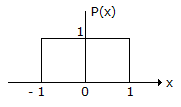ECE :: Exam Questions Paper
-
Polarization is a measure of
-
Thin gate oxide in a CMOS process in preferably grown using
-
Which of the following devices is a 'hot-electron' diode?
-
If D, G and η denote the directly, power gain and efficiency of an antenna, then which of the following relation holds :
-
A system described by the transfer function
 is stable. The constraints on a and K are
is stable. The constraints on a and K are -
Consider a random noise voltage which has a uniform density function as shown in the figure and is known to be white.

If the noise is the first quantized into 0.1 V steps, starting at 0 V level, and then readings made of 10 per second. The information content of the reading is : -
Consider the following statements:
The bias stability of an emitter-bias amplifier circuit improves by- decreasing the value of RB
- increasing the value of RE
- decreasing the value of RB
- increasing the value of RB
- increasing the value of RC
-
Consider the following:
- Si
- Ge
- GaAs
- InP
-
Which device can detect the presence of both forward and backward waves in a waveguide?
-
The correct sequence of subsystems in an FM receiver is
|
A.
Mixer, RF amplifier, Limiter, IF amplifier. Discriminator, Audio amplifier
|
|
B.
RF amplifier, Mixer, IF amplifier, Limiter, Discriminator, Audio amplifier
|
|
C.
RF amplifier, Mixer, Limiter, Discriminator IF amplifier, Audio amplifier
|
|
D.
Mixer, IF amplifier, RF amplifier, Audio amplifier, Discriminator
|


 Whatsapp
Whatsapp
 Facebook
Facebook

